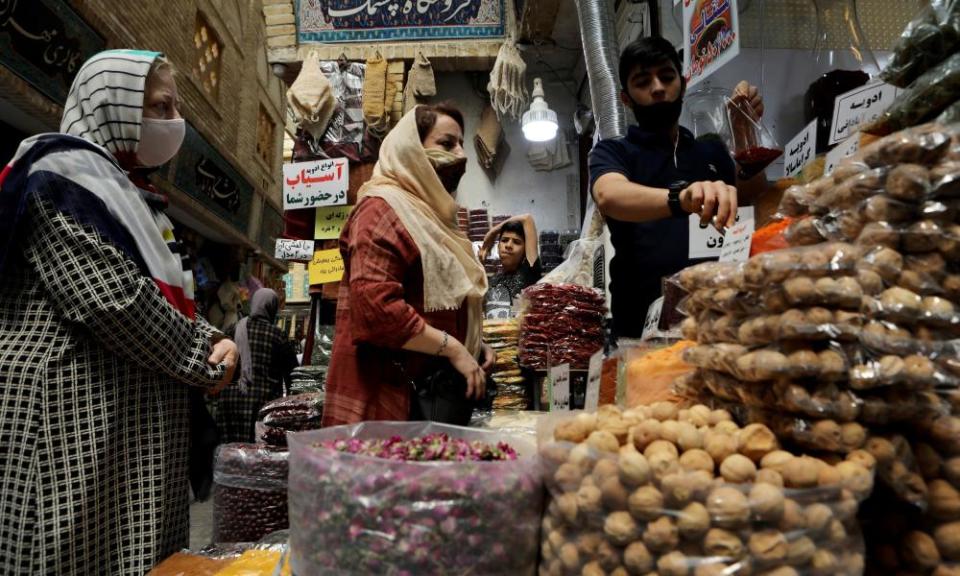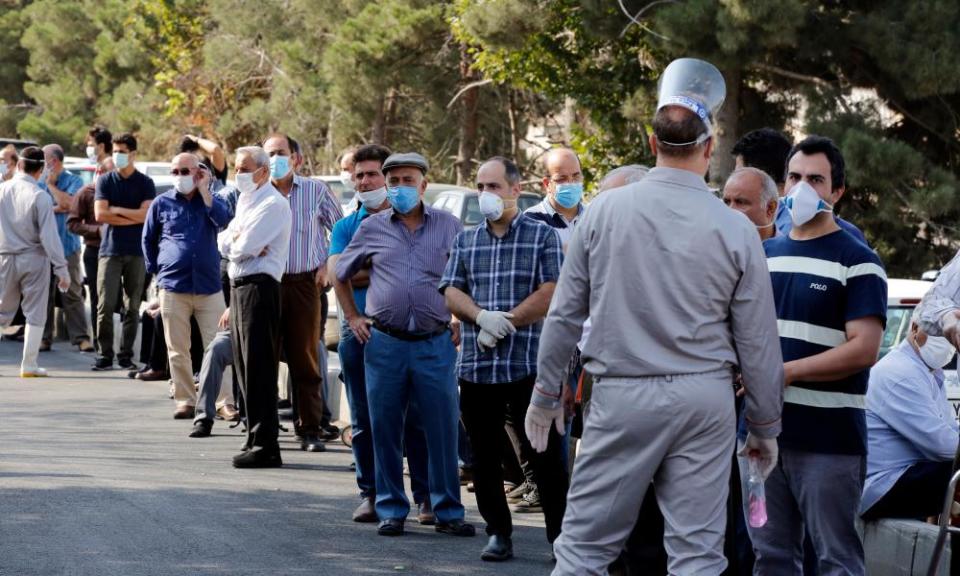Iran's Covid death toll three times higher than admitted, says report

One person is dying from Covid-19 every seven minutes in Iran, state television in the country has said, as a report claimed the overall toll from the virus was three times higher than authorities have admitted.
A health ministry spokeswoman said on Monday that 215 people had died in the past 24 hours, on top of more than 200 the previous day – the country’s highest figures in nearly a month.
State TV broadcast footage of busy Tehran streets with few face masks in sight despite government mandates that they should be worn on public transport and in covered spaces.
Iran’s official death toll is more than 17,000, but the BBC’s Farsi service said on Monday it had seen government documents indicating that the total was actually more than 42,000.
The outlet said the records sent by an anonymous source showed the country’s first Covid-19 death occurred on 22 January, a month earlier than the first official case, and that overall confirmed infections were about 451,000 as of 22 July – nearly double the public figures.
Even before these figures, Iran was considered to have the worst outbreak in the Middle East. It was among the first countries along with China, Italy and Spain to witness exponential growth in infections from February.
Daily cases officially peaked at more than 3,000 at the end of March and then dipped as the government imposed social distancing measures and closed bazaars, malls and mosques and banned travel between provinces.
default
Most of the rules were lifted in May to mitigate the damage to Iran’s sanctions-strapped economy. Activity resumed gradually throughout the month at mosques, parks, shrines and restaurants, and cases again began to soar.
There have been persistent doubts over the reliability of Iran’s official death toll throughout the pandemic, including in its early months when satellite images showed authorities were building mass graves in the city of Qom, one of the first places in the country to be overwhelmed by the virus.
At the time, the official death toll in the city was about 12, which an Iranian legislator claimed at the time was false, saying he knew of at least 50 deaths. The BBC data says Qom is the worst-hit city in Iran, with about 1,419 deaths or one for every 1,000 residents.
Video surfaced in April that was said to be from a mortuary in Qom showing rooms lined with the bodies of Covid-19 victims, which the one of the workers in the footage claimed had been there for up to five or six days.
Another sign of the size of the outbreak came last month when Iran’s president, Hassan Rouhani, quoted a health ministry study that estimated 25 million people in the country might have been infected, with a further 35 million at risk of contracting the virus in the next months.
The figures published by the BBC proportionally mirror the curve of the official statistics but are significantly higher.
The country’s health minister, Saeed Namaki, has blamed Iranians for not following social distancing guidelines.
A shopkeeper in the northern Qazvin province said hospitals and medical centres in his area were crowded and masks were rarely worn.
“The only precautions that the government has put in place is you can’t enter a government office or bank or medical clinic without a mask, and that’s it,” Ashkan Rahimi, 32, told Guardian.
“Most people are ashamed to reveal they have the virus. My grandmother was sick some days ago and I took her to a clinic … the doctor told me to take a coronavirus test, but I didn’t – I just left the clinic. It was too crowded.”

Sara Amiri, a medical researcher in the city of Tabriz, considered to be in the worst-hit “red” category, blamed US sanctions for shortages of medicine and disinfectants. “Hospitals are overcrowded, there is a lack of ICU beds in the province and health workers are tired,” she said.
“Drugs like cefixime and azithromycin can be found but drugs like chloroquine and Tamiflu which patients in severe condition need cannot be found, and people have been getting it for very high prices on the black market.”
The virus has struck several Iranian senior officials, including a vice-president, the deputy health minister and most recently the government’s spokesman Ali Rabiei.
The outbreak is one of several crises to trouble the Islamic Republic at a time when it was supposed to mark 40 years since its founding after Iran’s 1979 revolution. Its economy was predicted to stabilise this year but is now forecast to shrink by 6%, according to the World Bank.
A crackdown on massive protests last November in which hundreds of civilians were killed continued to reverberate and threaten further unrest. The regional projects of Iran’s Revolutionary Guards are said to be struggling to recover from January’s assassination of Gen Qassem Suleimani by the US.
Faith in the state was deeply shaken by the accidental shooting down of a Ukrainian passenger jet near Tehran carrying dozens of Iranian nationals, and a subsequent alleged cover-up.

 Yahoo News
Yahoo News 